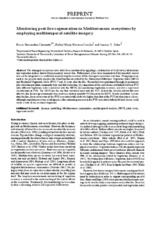Monitoring post-fire regeneration in Mediterranean ecosystems by employing multitemporal satellite imagery
Autor
Hernández Clemente, Rocío
Navarro Cerrillo, Rafael M.
Gitas, Ioannis Z.
Editor
CSIRO PUBLISHINGFecha
2009Materia
Dynamic modellingMediterranean communities
Multitemporal analysis
NDVI
Plant cover
Regression model
METS:
Mostrar el registro METSPREMIS:
Mostrar el registro PREMISMetadatos
Mostrar el registro completo del ítemResumen
Fire-damaged ecosystems have often been monitored by applying a combination of field survey information and vegetation indices derived from remotely sensed data. Furthermore, it has been demonstrated that remotely sensed data can be integrated as a useful tool in predicting the recovery of fire-damaged ecosystems over time. Using regression models, the present study analyzes the trend function described by the Normalized Difference Vegetation Index (NDVI) and Fractional Vegetation Cover (FVC) 7 and 12 years after the fire. The method was performed through (i) permanent plot collection per plant community type and data reduction; (ii) comparison of the correlation established between FVC with different vegetation index contrasted with the NDVI; (iii) monitoring vegetation recovery; and (iv) a supervised classification of FVC. The NDVI was the one that correlated most with the FVC. In both the seventh and twelfth year after fire, the linear regression model was used to accurately quantify FVC based on the NDVI. Results show that 12 years after the fire, the recovery rate of the FVC associated with scrub was higher than that of the FVC of other forest classes. Although vegetation recovery is taking place, the continuing increase in the FVC associated with shrub land classes could create a state of successional stagnation.

